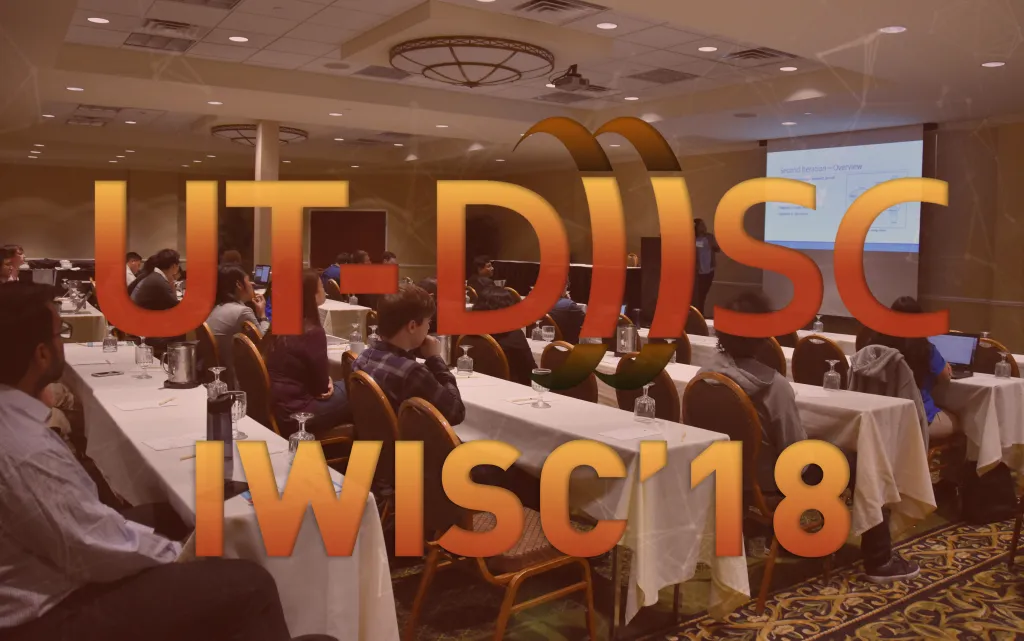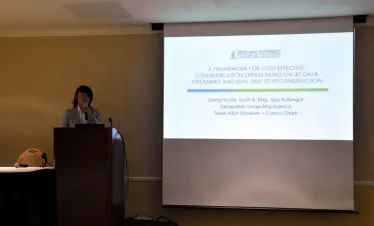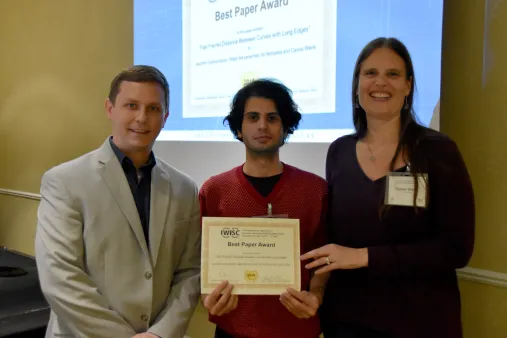UT-DIISC Organizes the Third International Workshop on Interactive and Spatial Computing (IWISC)

The UT Dallas Institute of Interactive and Spatial Computing (UT-DIISC) held its third International Workshop on Interactive and Spatial Computing (IWISC) in Dallas, Texas, on April 12thand 13th. IWISC is an international workshop that provides a forum for international researchers and practitioners from academia, industry, and government to present and discuss state-of-the-art research and concepts within the field of interactive and spatial computing. The two-day workshop was sponsored by the UT Dallas Computer Science Department.
The goal of the University of Texas Dallas Institute for Interactive and Spatial Computing (UT-DIISC) is to integrate activities within a broad spectrum of disciplines such as computational geometry, computer graphics, computer vision, (medical) image processing, high-dimensional data analysis, human-computer interaction, information visualization, multimedia systems, and virtual and augmented reality. These activities also enhance knowledge and human performance through applications in bioinformatics, physically-based modeling and simulation, and training and education.
The 3rdInternational Workshop on Interactive and Spatial Computing (IWISC 2018) consisted of research demonstrations, poster and paper presentations, industry panel discussions, and two keynote speeches Dr. Sethuraman “Panch” Panchanathan, Executive Vice-President, Arizona State University and Dr. Joseph (Michael) Coyle, Program Manager, Computer Science, US Army Research Office.
The invited talks, panel discussions, and research presentations covered all areas related to interactive computing and spatial computing. This year’s industry panel discussion was titled “Research Challenges in Building Smart and Connected Communities,” and included Drs. Ladan Pickering (Fujitsu), Bala Balasekar (Phazr), Kamakshi Sridhar (Sandvine), and Kumaran Vijayasankar (Texas Instruments). The following is a list of the invited industry talks, that were included for the first time:
- “The Connected Jobsite” by Shawn Dawson and James Wagner, Project Atlas
- “VR & Innovation Explorations” by Justin Restivo, Citi Architecture and Technology Engineering (CATE)
- “Machine Learning for Brain Imaging: Automatic Detection of Artifacts in Magnetoencephalography Using Convolutional Neural Networks” by Dr. Albert Montillo, University of Texas Southwestern Medical School
- “Virtual Reality: A New Dimension for Congenital Heart Disease” by Dr. Animesh (Aashoo) Tandon, University of Texas Southwestern Medical School
Each year IWISC provides a forum for attendees to explore other research groups’ latest, ongoing research in the fields of interactive and spatial computing. During the poster and demonstration portion of the workshop, attendees are given the opportunity for direct interaction with academics, researchers, and industry personnel who are there to exhibit their newest scientific contribution to the field of Interactive and Spatial Computing. Below is a list of the fifteen demonstrations and posters presented at IWISC’18. Proceedings of IWISC will be published through the ACM DIgitial Library.
“IWISC provides a forum where practitioners and researchers meet to collaborate on novel applications that will push the envelope, especially, in applying advanced computing to medicine,” said Dr. Balakrishnan Prabhakaran, director of UT-DIISC and Professor of Computer Science at UT Dallas. “We plan to organize IWISC every year and make it into a successful, international event,” he added.
Demonstrations:
- “Surgical Planning Using Virtual Reality” by Rohan Gupta, Anthony Lau, Adharsh Rajendran, Tanushri Singh, Pooshan Shah, Ryan P. McMahan, Tarique Hussain and Animesh Tandon
- “Virtual Reality: Impacts on Eating Habits” by Xinyu Hu and Ryan P. McMahan
- “VIGOR: Virtual Interaction with Gravitational Waves to Observe Relativity” by Midori Kitagawa, Monisha Elumalai, Michael Kesden, Mary Urquhart and Roger Malina
- “Virtual Reality Demonstration for Training Robotic Operating-Room Staff” by Ryan P. McMahan, James Coleman Eubanks and Alec Moore
- “Navigation Mechanisms for Collaborative, Mixed Reality Tours” by Shanthi Vellingiri and Balakrishnan Prabhakaran
- “Brain Segmentation and Visualization Platform Demonstration” by Andrew Wilson, Xiaohu Guo, Yeqi Wang, Thomas Stanley and Asad Khan
Posters:
- “Applying Algorithms to Visual Design Principles in M-Learning” by Elizabeth Berger and Ryan P. McMahan
- “Improved line facility location in weighted subdivisions” by Ovidiu Daescu and Ka Yaw Teo
- “EvalVR: Evaluation of User Experience of popular Virtual Reality Applications” by Sanika Gupta, Maher Abujelala and Fillia Makedon
- “Computing Robust Principal Components by A* Search” by Baokun He, Swair Shah, Crystal Maung and Haim Schweitzer
- “Automatic Labeling of Resting State fMRI Networks using 3D Convolutional Neural Networks” by Gowtham Krishnan, Prabhat Garg, Elizabeth Davenport, Ben Wagner, Christopher Whitlow, Joseph Maldjian and Albert Montillo
- “Cognitive Demands on 3D Travel Techniques” by Chengyuan Lai and Ryan P. McMahan
- “Robust Geometric Computations for Neutron Tracking” by David Millman and Jack Snoeyink
- “Solving Generalized Column Subset Selection with Heuristic Search” by Swair Shah, Ke Xu, Baokun He, Crystal Maung and Haim Schweitzer
- “Sparse Approximate Conic Hulls” by Greg Van Buskirk, Benjamin Raichel and Nicholas Ruozzi
IWISC includes not only poster and demonstration sessions of current research projects, but also oral presentations of technical papers. Below is a complete list of research papers presented at this year’s IWISC.
Research Papers I: Grammars & Visualization
- “Quantitative Spatial Semantics in A Graph Grammar Formalism” by Yufeng Liu, Xiaoqin Zeng and Kang Zhang
- “Enhancements to A Shape Grammar Interpreter” by Xiaoyu Wang and Kang Zhang
- “Visualization of Genome Rearrangements Using DCJ Operations” by Sruthi Chappidi and Sergey Bereg
Research Papers II: Computer Vision and Detection
- “Simplified Heart-Rate Measurement from Video” by Juan L. Alonso- Cuevas and Raul E. Sanchez- Yanez
- “Saliency improvement through Genetic Programming” by Diana E. Martinez- Rodriguez, Marco A. Contreras-Cruz, Uriel H. Hernandez-Belmonte, Sergey Bereg and Victor Ayala-Ramirez
- “Exploring Functional Clinical Attributes For Macular Dystrophy Detection” by Rittika Shamsuddin, Yi- Zhong Wang and Balakrishnan Prabhakaran
Research Papers III: Computational Geometry
- “Map-Matching Using Shortest Paths” by Erin Chambers, Brittany Terese Fasy, Yusu Wang and Carola Wenk
- “Fast Frechet Distance Between Curves with Long Edges” by Joachim Gudmundsson, Majid Mirzanezhad, Ali Mohades and Carola Wenk
- “Improved Line Facility Location in Weighted Subdivisions” by Ovidiu Daescu and Ka Teo
Research Papers IV: Virtual Reality
- “Physical Hand Interaction for Controlling Multiple Virtual Objects in Virtual Reality” by Mohamed Suhail Mohamed Yousuf Sait, Shyam Prathish Sargunam, Dustin T. Han and Eric D. Ragan
- “Evaluating Joystick Control for View Rotation in Virtual Reality with Continuous Turning, Discrete Turning, and Field-of-View Reduction” by Shyam Prathish Sargunam and Eric D. Ragan
- “LearnDNA: An Interactive VR Application for Learning DNA Structure” by Lakshmi Sharma, Rong Jin, Balakrishnan Prabhakaran and Murry Gans
Research Papers V: Multimedia
- “A Framework for Cost-Effective Communication System for 3D Data Streaming and Real-Time 3D Reconstruction” by Dang Huynh, Scott A. King and Ajay K. Katangur
- “Classification of Multiple Sclerosis and Non-Specific White Matter Lesions using Spherical Harmonics Descriptors” by Yeqi Wang, Madison Hansen, Darin Okuda, Andrew Wilson and Xiaohu Guo
- “Monitoring Task Engagement using Facial Expressions and Body Postures” by Akilesh Rajavenkatanarayanan, Ashwin Ramesh Babu, Konstantinos Tsiakas and Fillia Makedon
UT-DIISC was established at UT Dallas in Fall 2015 with members from academia, industry, and international research institutions. The founding members include UT Dallas Computer Science faculty members, Drs. Balakrishnan Prabhakaran (Director of UT-DIISC), Sergey Bereg (Associate Director), Ovidiu Daescu, Ryan McMahan, Haim Schweitzer, Xiaohu Guo, Kang Zhang, and Benjamin Raichel. UT-DIISC partners include UT Southwestern Medical Center,University of Guanajuato, Mexico, Texas A&M University, and the Retina Foundation of the Southwest.
The 4thInternational Workshop on Interactive and Spatial Computing (IWISC) will take place at the University of Guanajuato, Mexico.
Click here to visit the UT-DIISC Homepage.
Click here to view photos from day one of IWISC’18 and click here to view day two of IWISC’18.




ABOUT THE UT DALLAS COMPUTER SCIENCE DEPARTMENT
The UT Dallas Computer Science program is one of the largest Computer Science departments in the United States with over 2,400 bachelors-degree students, more than 1,000 master’s students, 150 Ph.D. students, 53 tenure-track faculty members and 38 full-time senior lecturers, as of Fall 2017. With The University of Texas at Dallas’ unique history of starting as a graduate institution first, the CS Department is built on a legacy of valuing innovative research and providing advanced training for software engineers and computer scientists.




